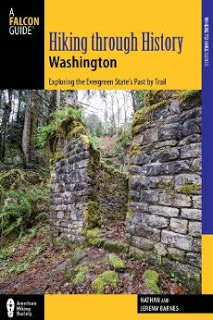Bordeaux Ghost Town
Total Distance: 0.0 miles
Total Ascent: 0ft
Highest Point: 0ft
Total Ascent: 0ft
Highest Point: 0ft
Difficulty: Easy
Our Hiking Time: 0
Required Permit: None
Our Hiking Time: 0
Required Permit: None
Today, Bordeaux is a protected archaeological site most of which is situated on private property. In recent years, visitors have left trash, graffiti and significantly damaged Bordeaux's structures. Both for these reasons and to prevent further erosion to the property, the land managers are no longer allowing visitors to the site.
If you're in this area, check out the Capitol State Forest or Mima Mounds for some other hiking and exploring options.
One of those camps was situated along Mima Creek and became the drop off point for the less profitable cedar logs. To address this issue, the company formed a subsidiary, named the Mumby Lumber and Shingle Company after Samuel C. Mumby, the manager the Bordeauxs assigned the task of creating a shingle business. For a time, the settlement was referred to simply as Mumby, until a shingle sawmill was constructed in 1902, which immediately transformed the settlement from a camp to a town. Hundreds of workers were suddenly living in the area and a post office called Bordeaux was opened in 1903, named for the president of the enterprise that made the company town possible.
Mumby shingles quickly became a recognized brand in the Midwest and the company kicked into high gear, building nearly 90 miles of track and stripping the Black Hills bare by 1916. By this time Bordeaux boasted a general store, hotel, school, work houses, and homes. As the timber needed to fuel Bordeaux got further away, loggers simply bunked on the railroad cars, and used progressively more sophisticated methods of harvesting timber, graduating from oxen to Steam Donkeys and eventually tractors. The breakneck pace could not last indefinitely, and in 1927 the company had stripped everything it could out of Mason County and Bordeaux began a long decline. In 1933 the company began to sell off its holdings around Olympia to the state, which had grown weary of the forest fires and clear cutting so near the state capital. These purchases formed the foundation of what would eventually become Capitol Forest.
As the years passed, the timber came from further and further afield until 1941, when the company cut its last tree, marking the end of an endeavor that cut and milled more than 3.5 billion feet of logs. Bordeaux was shuttered the following year, much of it bulldozed and pulled down. Today what remains is slowly being taken back by the same forest the town worked so hard to destroy.
If you're in this area, check out the Capitol State Forest or Mima Mounds for some other hiking and exploring options.
History
Sometime back in the late 1870s, a young Wisconsin lumberman named Thomas Bordeaux visited the forests around Olympia. He found vast tracks of colossal firs, cedars and hemlock, but knowing that the Northern Pacific Railroad was aiming to connect the Puget Sound to the rest of the country in 1883, he made plans to return when the railroad was complete. In 1885 he returned with his brother Joseph with the aim of harvesting as much of this largely untapped forest as he could. They began with small tracks timber and oxen teams that had some difficulty with the hilly terrain. By 1891 they had laid down their first railroad track and purchased a steam engine. The following year Thomas and Joseph (not Russell as some sources suggest, Russell was a son of Thomas) incorporated the Mason County Logging Company along with another investor. Thomas took on the president of the new company, a position he would hold until 1928. Over the next 10 years, railroads began to snake into the surrounding forests and dozens of logging camps sprouted up along the tracks.One of those camps was situated along Mima Creek and became the drop off point for the less profitable cedar logs. To address this issue, the company formed a subsidiary, named the Mumby Lumber and Shingle Company after Samuel C. Mumby, the manager the Bordeauxs assigned the task of creating a shingle business. For a time, the settlement was referred to simply as Mumby, until a shingle sawmill was constructed in 1902, which immediately transformed the settlement from a camp to a town. Hundreds of workers were suddenly living in the area and a post office called Bordeaux was opened in 1903, named for the president of the enterprise that made the company town possible.
Mumby shingles quickly became a recognized brand in the Midwest and the company kicked into high gear, building nearly 90 miles of track and stripping the Black Hills bare by 1916. By this time Bordeaux boasted a general store, hotel, school, work houses, and homes. As the timber needed to fuel Bordeaux got further away, loggers simply bunked on the railroad cars, and used progressively more sophisticated methods of harvesting timber, graduating from oxen to Steam Donkeys and eventually tractors. The breakneck pace could not last indefinitely, and in 1927 the company had stripped everything it could out of Mason County and Bordeaux began a long decline. In 1933 the company began to sell off its holdings around Olympia to the state, which had grown weary of the forest fires and clear cutting so near the state capital. These purchases formed the foundation of what would eventually become Capitol Forest.
As the years passed, the timber came from further and further afield until 1941, when the company cut its last tree, marking the end of an endeavor that cut and milled more than 3.5 billion feet of logs. Bordeaux was shuttered the following year, much of it bulldozed and pulled down. Today what remains is slowly being taken back by the same forest the town worked so hard to destroy.
Nearby hikes
Similar Difficulty
Similar Features












